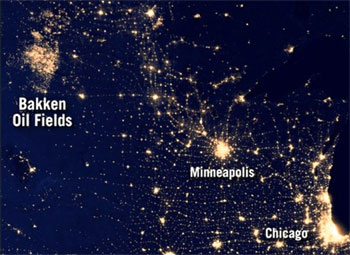In the midst of widespread protests and lawsuits, the natural gas industry has formed a task force that promises to stop the practice of flaring, responsible for releasing huge amounts of greenhouse gases into the atmosphere, particularly methane.
The task force, which represents hundreds of companies in
North Dakota, says it will be able to capture almost
all the natural gas that’s flared in the Bakken shale oil field by the
end of the decade.
Bakken produces an astounding 760,000 barrels of natural gas a day, growing from 18,500 in just the past six years.
Right now, flaring releases six million tons of carbon
into the atmosphere every year, about the same as three
medium-sized coal plants. The wasteful practice sends about 29% of fracked gas into the air, worth about $1 billion a year, according to a study by Ceres.
And that would be profitable for the industry, adding $2 billion a year to its bottom line, according to the report, Leaking Profits.
Remember this image? These NASA satellite image shows the Bakken field from space – as bright as nearby cities.

"The U.S. is now one of the top 10 flaring countries in the world, primarily due to the rapid growth of flaring in North Dakota," says Ryan Salmon, lead author of Ceres’ report, "Flaring Up."
The industry believes it can capture 85% of natural gas in two years, up from 70% today, and to as much as 90% in six years.
And that’s with rising production in the Bakken field, expected to grow 40% by the end of 2015.
The task force believes it can meet those goals in two ways. First, they would require drilling companies to have a plan to capture gas before they could get a drilling permit. Existing wells might have to restrict production if they can’t come up with a way to capture gas. Second, they would speed up construction of pipelines that carry the captured gas to processing plants.
North Dakota would have to support the rapid build-out of pipelines with tax credits for both property and production, and incentives that spur local
industry to use the gas for fuels, petrochemicals and fertilizers.
"It looks like a pretty good
solution," State Senator Connie Triplett, told the NY Times. "They actually invited regulation from the
Industrial Commission, which has to be a first for the oil industry in North
Dakota."
The state set a target that limits flaring to 10% of production, but there’s no date by when it must be met.
Opposition to flaring and a rash of explosive train accidents have pushed even the strongest defenders of the industry to say there has to be a better balance between production and concern for public safety and the environment.
In 2012, institutional investor members of Ceres urged the 21 largest natural gas producers to reduce or eliminate flaring.
California Too?
Meanwhile in California, Governor Brown, who typically doesn’t need persuading on environmental matters, is allowing fracking to grow in the state. Last year, a bill that would ban fracking in California failed to pass, even with a majority of Democrats in both houses.
California’s Monterey Shale could store two-thirds of US gas reserves, some 15.4 billion barrels of oil – apparently too much to pass up. It just happens to be a hotspot for earthquakes
Instead, they passed SB4, which regulates gas drilling starting in 2015. Like Colorado’s law, it requires, companies to get a permit, conduct groundwater tests, disclose the chemicals they use and notify nearby property owners.
20 top climate scientists sent Governor Brown a letter, exhorting him to place a moratorium on the practice.
"If what we’re trying to do is stop using the sky as a waste dump for our carbon pollution, and if we’re trying to transform our energy system, the way to do that is not by expanding our fossil fuel infrastructure," Ken Caldeira, an atmospheric scientist at the Carnegie Institution for Science at Stanford University, told Mercury News.
Some of the other prominent signatories are James Hansen, Richard Houghton, President of Massachusetts-based Woods Hole Research Center, and Michael Mann, professor of meteorology at Penn State University.
In Brown’s response, he points to the strict fracking regulations and the comprehensive environmental analysis of fracking that’s due by 2015. After that, based on the research, he’ll consider a moratorium, he says. Why would you go ahead with fracking before the research shows it’s safe? (which we all know, it isn’t).
Read our article, US Methane Emissions Beat Estimates, Thanks to Fracking.
Read the report, Flaring Up:

http://northdakotapipelines.com/natgasfacts/
This says: ND flare is 29% of US but only 1% of world flare…if the entire US is only 3% of world flare, where does the Ceres yahoo get off saying we’re in top ten world flarers?!?!(unless it is spread almost uniformly across the planet?)